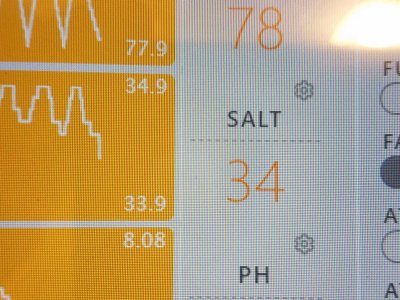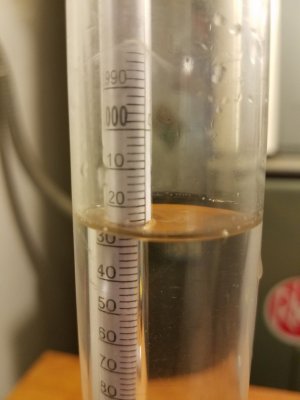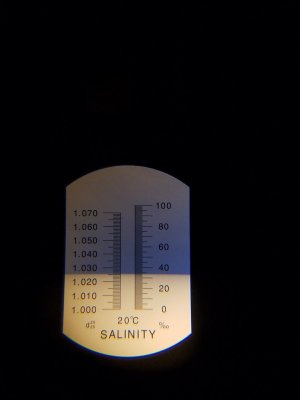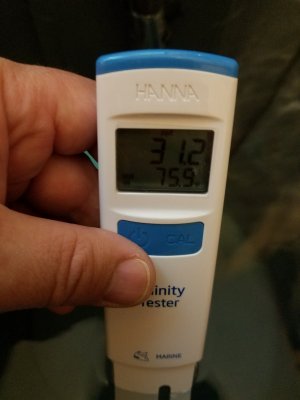Navigation
Install the app
How to install the app on iOS
Follow along with the video below to see how to install our site as a web app on your home screen.
Note: This feature may not be available in some browsers.
More options
You are using an out of date browser. It may not display this or other websites correctly.
You should upgrade or use an alternative browser.
You should upgrade or use an alternative browser.
NEW HI98319 Hanna Waterproof Salinity and Temperature Tester
- Thread starter Hanna Instruments
- Start date
- Tagged users None
Users Who Are Viewing This Thread (Total: 1, Members: 0, Guests: 1)
How so? How would it be any different?You need 2 different value solutions, a 35.1 and a 32.1 for example. Using 2 of the same value is probably not an effective check.
- Joined
- Jan 29, 2019
- Messages
- 608
- Reaction score
- 567
You would only be test for repeatability of the calibration point not the validity of the range. Obviously if you saw 36 or something for the calibration something would be wrong. In an ideal world you would calibrate in the middle and test a value in the highest and lowest range but a single direction is generally good enough
I see. Well that seems like a good idea in theory but I have doubts as to how many people would be able to get their hands on multiple different reference solutions.You would only be test for repeatability of the calibration point not the validity of the range. Obviously if you saw 36 or something for the calibration something would be wrong. In an ideal world you would calibrate in the middle and test a value in the highest and lowest range but a single direction is generally good enough
I'm having an issue where the Hanna meter goes off calibration after about a 30 days.
Is this everyones case? I find that too frequent. A refractometer, given that you don't drop it or bang it around pretty much stays calibrated. But the Hannah goes off calibration from 1.026 to 1.024 in about a months time. I find that too frequent and excessively using up my calibration packets that I have to constantly buy.
Is calibration going off every 30 days the norm for the Hanna? I rinse with RO water everytime I use it and dry it with a paper towel. Is there any other method I can do to keep the calibration as stable as possible for as long as possible?
EDIT: One weird thing to note, which was what led me to recalibrate was that I had 3 separate readings. One was my mixing container. One was a reef tank and another smaller reef tank. All 3 showed 1.024 reading on the Hanna. I thought that was odd, because the refractometer showed slight variances in all three. About 1024 in one, 1.025 in another and 1.026 in another. Granted, its analog and line of sight and using best judgement as to the clarity of separation of the white and blue line, but clearly there were variances and the Hanna read all 3 as 1.024 before calibration.
After I recalibrated the Hanna, the Hanna showed that all three were different. One was actually 1.023, one was 1.025 and another was 1.026. Anyh reason why the hanna read all three the same pre-calibration?
Is this everyones case? I find that too frequent. A refractometer, given that you don't drop it or bang it around pretty much stays calibrated. But the Hannah goes off calibration from 1.026 to 1.024 in about a months time. I find that too frequent and excessively using up my calibration packets that I have to constantly buy.
Is calibration going off every 30 days the norm for the Hanna? I rinse with RO water everytime I use it and dry it with a paper towel. Is there any other method I can do to keep the calibration as stable as possible for as long as possible?
EDIT: One weird thing to note, which was what led me to recalibrate was that I had 3 separate readings. One was my mixing container. One was a reef tank and another smaller reef tank. All 3 showed 1.024 reading on the Hanna. I thought that was odd, because the refractometer showed slight variances in all three. About 1024 in one, 1.025 in another and 1.026 in another. Granted, its analog and line of sight and using best judgement as to the clarity of separation of the white and blue line, but clearly there were variances and the Hanna read all 3 as 1.024 before calibration.
After I recalibrated the Hanna, the Hanna showed that all three were different. One was actually 1.023, one was 1.025 and another was 1.026. Anyh reason why the hanna read all three the same pre-calibration?
Last edited:
I had to recalibrate almost twice a week .. my current reflactometer behaves but not otherwise and that is from aqua medic
the hanna part is basically useless. recalibrating this eternal with your own solution only costs unnecessarily much money.
the hanna part is basically useless. recalibrating this eternal with your own solution only costs unnecessarily much money.
Just stumbled onto this topic, mine reads about 0.002 lower than my refractometers. So far it has been consistent with that which is more important, curious to see if it stay's this way going forward.
I did get burned on that icecap salinity pen so I was skeptical going into this purchase.
That icecap pen got me too. I didn't even want to sell it, just tossed it. I didn't like the Milwaukee much, sold it pretty fast.
Hanna has been working well for me still. No complaints. Not had to recalibrate it yet.
- Joined
- Feb 19, 2017
- Messages
- 111
- Reaction score
- 220
Ahhh I was quite happy with mine until I read this
Mine also working as it should
Mine also working as it should
I am having similar issue with mine that others seem to have. When I picked it up from a LFS, I took it home, placed the calibration packet in the sump to temperature acclimate to the tanks temp. At the same time I did it for my Apex calibration solution and my refractometer's calibration solution. I re-calibrated all 3 instruments.
Apex and refractometer had my tank at 34.5-35 ppt, Hanna had it at 31 ppt. I was also doing a water change and had 30 gallons of freshly mixed water, refractometer had it a 35 ppt and Hanna had it at 34.5...close but what the heck! Is this not intended to read tank water and only good for freshly mixed? Hanna advertises as good for tank readings but not if it reads tank water too low. I used 3 of the 4 calibration packets thinking I messed up. But all 3 calibrations resulted in the same variation in readings from tank water but was pretty much spot on with the refractometer for freshly mixed.
Apex and refractometer had my tank at 34.5-35 ppt, Hanna had it at 31 ppt. I was also doing a water change and had 30 gallons of freshly mixed water, refractometer had it a 35 ppt and Hanna had it at 34.5...close but what the heck! Is this not intended to read tank water and only good for freshly mixed? Hanna advertises as good for tank readings but not if it reads tank water too low. I used 3 of the 4 calibration packets thinking I messed up. But all 3 calibrations resulted in the same variation in readings from tank water but was pretty much spot on with the refractometer for freshly mixed.
- Joined
- Oct 7, 2017
- Messages
- 187
- Reaction score
- 69
This is strange works perfect for me with my tank and freshly mixed water and very close to refractometerI am having similar issue with mine that others seem to have. When I picked it up from a LFS, I took it home, placed the calibration packet in the sump to temperature acclimate to the tanks temp. At the same time I did it for my Apex calibration solution and my refractometer's calibration solution. I re-calibrated all 3 instruments.
Apex and refractometer had my tank at 34.5-35 ppt, Hanna had it at 31 ppt. I was also doing a water change and had 30 gallons of freshly mixed water, refractometer had it a 35 ppt and Hanna had it at 34.5...close but what the heck! Is this not intended to read tank water and only good for freshly mixed? Hanna advertises as good for tank readings but not if it reads tank water too low. I used 3 of the 4 calibration packets thinking I messed up. But all 3 calibrations resulted in the same variation in readings from tank water but was pretty much spot on with the refractometer for freshly mixed.
I am having similar issue with mine that others seem to have. When I picked it up from a LFS, I took it home, placed the calibration packet in the sump to temperature acclimate to the tanks temp. At the same time I did it for my Apex calibration solution and my refractometer's calibration solution. I re-calibrated all 3 instruments.
Apex and refractometer had my tank at 34.5-35 ppt, Hanna had it at 31 ppt. I was also doing a water change and had 30 gallons of freshly mixed water, refractometer had it a 35 ppt and Hanna had it at 34.5...close but what the heck! Is this not intended to read tank water and only good for freshly mixed? Hanna advertises as good for tank readings but not if it reads tank water too low. I used 3 of the 4 calibration packets thinking I messed up. But all 3 calibrations resulted in the same variation in readings from tank water but was pretty much spot on with the refractometer for freshly mixed.
When comparing conductivity to refractometery to measure salinity, the consensus among the scientific community favors conductivity. This is because there are non-conductive material in your sample which can impact the refractive index of seawater but not the actual salt concentration. For example, if we add sugar to artificial seawater, we will see that our salinity value will increase but we have not changed the concentration of salt in the water. If we measured the salinity of that sample with our HI98319 conductivity meter you’ll notice the value is largely unchanged. It is common to have inflated values with a refractometer due to the large number of materials which will affect the density of that water outside of the dissolved salt values. For example, anti-caking agent in salt mixes, organic waste, sugars, potential non-ionic contaminants or uneaten fish food can increase the values produced on a refractometer but this would be less likely to occur on a conductivity meter like the HI98319. Added bonuses of using conductivity to measure salinity are that you no longer have a light interference, and the temperature compensation is of your direct sample and not as influenced by ambient atmosphere near the surface of a prism.
We use the international oceanographic tables to convert conductivity to salinity. This is the preferred method by most marine scientists. This uses a 35ppt potassium chloride conductivity standard as the baseline for salinity values. You cannot use our HI70024P calibration solution for refractometers. This is important as many hobbyists try and think our standard is bad when they use it on their refractometer. This is because refractometers standards are density based while ours is made for electrical conductivity. The science behind each measurement is fundamentally different.
When comparing salinity measurement instruments you must also factor in the accuracy statement of the respective devices in the results. For example our HI98319 has an accuracy statement of ±1ppt and our HI96822 digital refractometer is ±2 ppt. If we get a reading of 33ppt on our HI98319 and a reading of 35 on our HI96822 then the results are in spec. The measure of uncertainty for the HI98319 would be 32ppt-34ppt while the measure of uncertainty for the HI96822 would be 33ppt-37ppt. The values would fall in line of one another.
Also when you calibrate your HI98319 salinity and temperature tester make sure you tap the calibration sachet to dislodge any entrapped air bubbles from the tip of the electrode. Having air bubbles in the tip of the electrode can cause improper calibration.
For assistance regarding any technical support issue please email [email protected]
When comparing conductivity to refractometery to measure salinity, the consensus among the scientific community favors conductivity. This is because there are non-conductive material in your sample which can impact the refractive index of seawater but not the actual salt concentration. For example, if we add sugar to artificial seawater, we will see that our salinity value will increase but we have not changed the concentration of salt in the water. If we measured the salinity of that sample with our HI98319 conductivity meter you’ll notice the value is largely unchanged. It is common to have inflated values with a refractometer due to the large number of materials which will affect the density of that water outside of the dissolved salt values. For example, anti-caking agent in salt mixes, organic waste, sugars, potential non-ionic contaminants or uneaten fish food can increase the values produced on a refractometer but this would be less likely to occur on a conductivity meter like the HI98319. Added bonuses of using conductivity to measure salinity are that you no longer have a light interference, and the temperature compensation is of your direct sample and not as influenced by ambient atmosphere near the surface of a prism.
We use the international oceanographic tables to convert conductivity to salinity. This is the preferred method by most marine scientists. This uses a 35ppt potassium chloride conductivity standard as the baseline for salinity values. You cannot use our HI70024P calibration solution for refractometers. This is important as many hobbyists try and think our standard is bad when they use it on their refractometer. This is because refractometers standards are density based while ours is made for electrical conductivity. The science behind each measurement is fundamentally different.
When comparing salinity measurement instruments you must also factor in the accuracy statement of the respective devices in the results. For example our HI98319 has an accuracy statement of ±1ppt and our HI96822 digital refractometer is ±2 ppt. If we get a reading of 33ppt on our HI98319 and a reading of 35 on our HI96822 then the results are in spec. The measure of uncertainty for the HI98319 would be 32ppt-34ppt while the measure of uncertainty for the HI96822 would be 33ppt-37ppt. The values would fall in line of one another.
Also when you calibrate your HI98319 salinity and temperature tester make sure you tap the calibration sachet to dislodge any entrapped air bubbles from the tip of the electrode. Having air bubbles in the tip of the electrode can cause improper calibration.
For assistance regarding any technical support issue please email [email protected]
I understand how to calibrate for conductivity, been doing it for a while with good results with my Apex. I used 3 of the 4 calibration packets that came with the meter, all came up with the same results of tankwater reading lower than both the refractometer and the Apex conductivity meter. Apex was calibrated at teh same time with their calibration solution, and refractometer calibrated with BRS refractometer calibration solution. What makes ZERO sense is why fresh water mix reads very similar on Hanna meter and refractometer, but off with tank water. Apex meter on both tank and freshly mixed yielded with 0.5 ppt of the refractometer. 31 vs 34.5 is out of spec. I have already contacted support and have a pending RMA.
I understand how to calibrate for conductivity, been doing it for a while with good results with my Apex. I used 3 of the 4 calibration packets that came with the meter, all came up with the same results of tankwater reading lower than both the refractometer and the Apex conductivity meter. Apex was calibrated at teh same time with their calibration solution, and refractometer calibrated with BRS refractometer calibration solution. What makes ZERO sense is why fresh water mix reads very similar on Hanna meter and refractometer, but off with tank water. Apex meter on both tank and freshly mixed yielded with 0.5 ppt of the refractometer. 31 vs 34.5 is out of spec. I have already contacted support and have a pending RMA.
You have more to patience than I. Mine would read low compared to Apex and GHL probes and refractometer. I shattered mine with a hammer so another would not suffer my same experience.
Have you tried taking tank water out of the tank and testing? Might be getting some interference with other electrical devices. Just a ideaI understand how to calibrate for conductivity, been doing it for a while with good results with my Apex. I used 3 of the 4 calibration packets that came with the meter, all came up with the same results of tankwater reading lower than both the refractometer and the Apex conductivity meter. Apex was calibrated at teh same time with their calibration solution, and refractometer calibrated with BRS refractometer calibration solution. What makes ZERO sense is why fresh water mix reads very similar on Hanna meter and refractometer, but off with tank water. Apex meter on both tank and freshly mixed yielded with 0.5 ppt of the refractometer. 31 vs 34.5 is out of spec. I have already contacted support and have a pending RMA.
Have you tried taking tank water out of the tank and testing? Might be getting some interference with other electrical devices. Just a idea
I have not done that. I will definitely try that. I do have grounding probes in my sump and tank, so hopefully no stray voltage issues. Not sure if plain old EMF affects a conductivity probe.
Have you tried taking tank water out of the tank and testing? Might be getting some interference with other electrical devices. Just a idea
Ok, tested with tank water taken out of the tank. Still about 2 points off. Hanna = 31.9, APEX = 34.4, Refractometer= 34 (maybe a hair under)
And tested with Fresh saltwater that I am prepping for rotifer bucket.
Hanna = 16.2, Refractometer= 16.8-ish (Just under 17 in blurry pic)


Hanna = 16.2, Refractometer= 16.8-ish (Just under 17 in blurry pic)
Definitely sending the Hanna in for RMA, I cant trust it after testing multiple times against other tests and multiple re-calibrations.
Pulled a sample of tank water to let it cool to 66 F (20 C) even though the refractometer is supposedly automatic temp calibration. Refract said 35 ppt and Hanna said 31.7 ppt.
Re-calibrated all my instruments and mixing fresh saltwater for a water change. Pulled a sample for the apex, hydrometer, refractometer and the Hanna. 3 of the 4 are close to each other, Hanna the furthest off by 8% assuming the baseline of 34 ppt from 2 instruments.
APEX = 34 ppt, HYDRO = 1.025 (33.2 ppt), Refractometer = 34 ppt, Hanna=31.2 ppt




Pulled a sample of tank water to let it cool to 66 F (20 C) even though the refractometer is supposedly automatic temp calibration. Refract said 35 ppt and Hanna said 31.7 ppt.
Re-calibrated all my instruments and mixing fresh saltwater for a water change. Pulled a sample for the apex, hydrometer, refractometer and the Hanna. 3 of the 4 are close to each other, Hanna the furthest off by 8% assuming the baseline of 34 ppt from 2 instruments.
APEX = 34 ppt, HYDRO = 1.025 (33.2 ppt), Refractometer = 34 ppt, Hanna=31.2 ppt




- Joined
- Sep 10, 2018
- Messages
- 1,533
- Reaction score
- 1,039
Can anyone tell me what the small "CAL" icon on the secondary display means? I calibrated, and it didn't go away.
Similar threads
- Replies
- 2
- Views
- 70
-
- AMS: Article
- Replies
- 11
- Views
- 1,405
- Price: $65
- Shipping Available
- Replies
- 5
- Views
- 508
- Price: $65
- Shipping Available
- Replies
- 0
- Views
- 361









